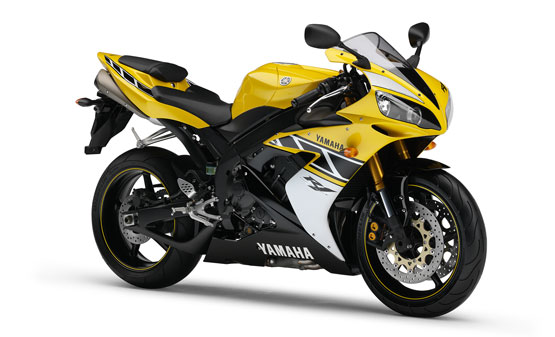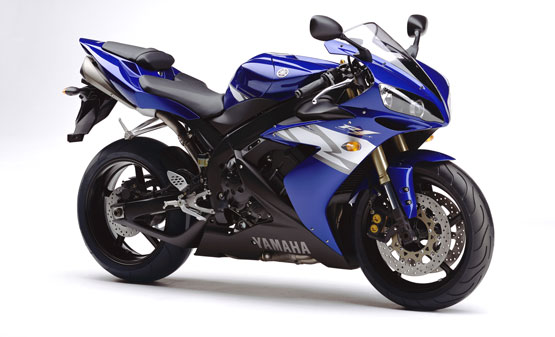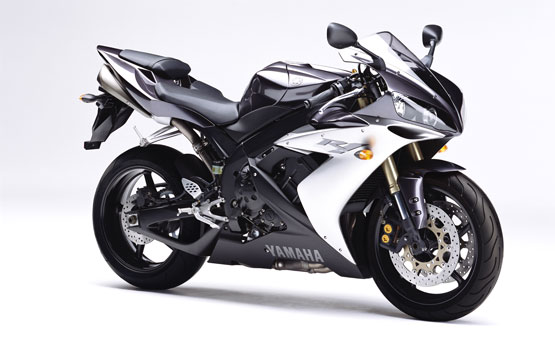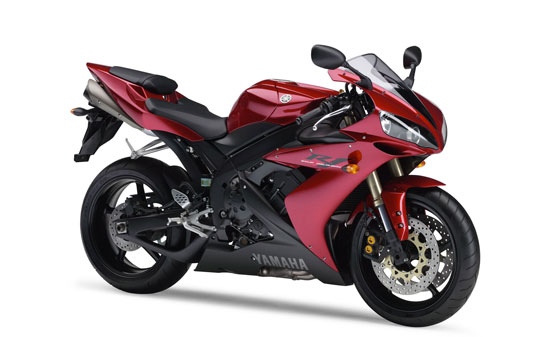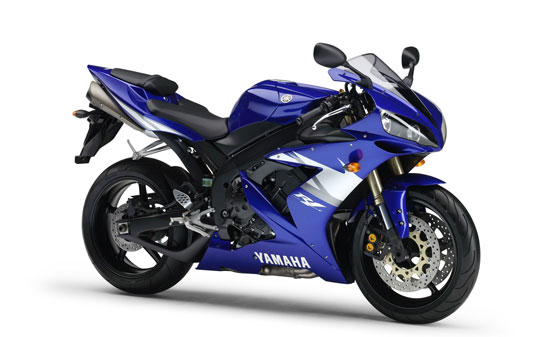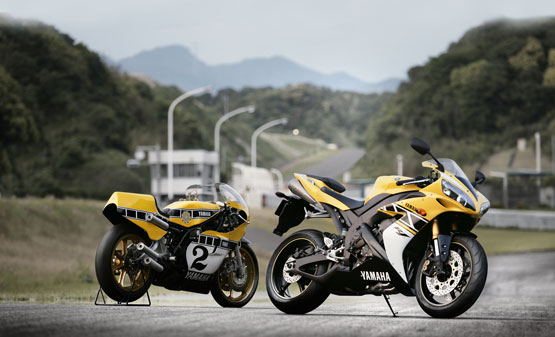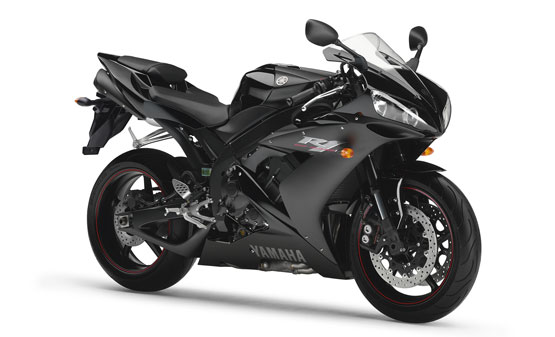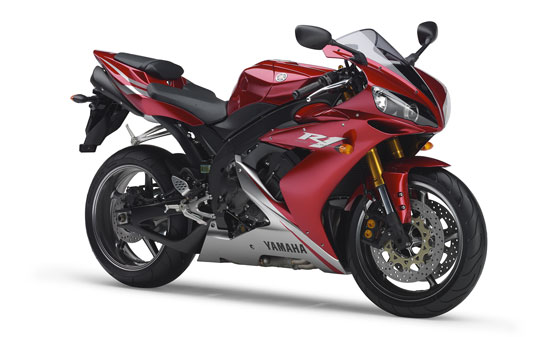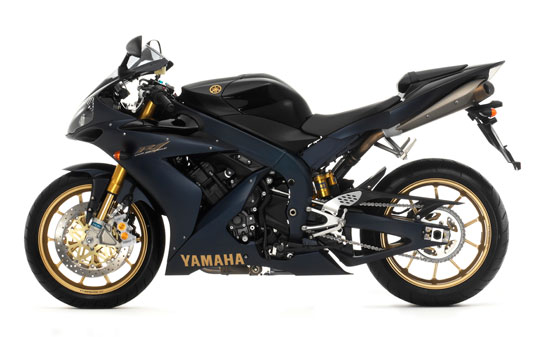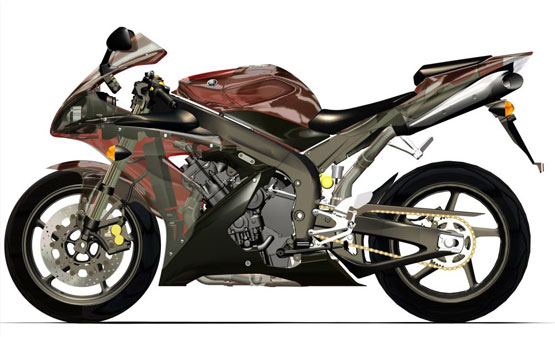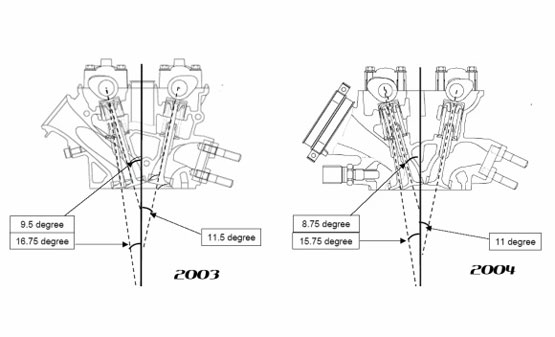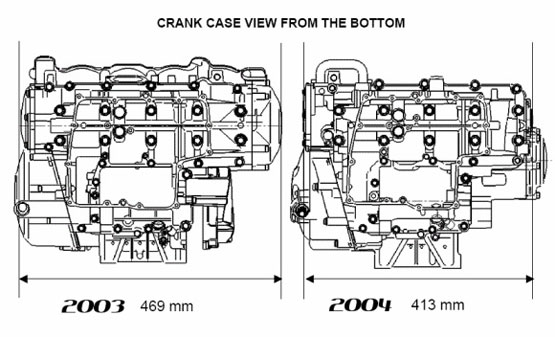Back to the Model History Timeline Review Page
2004 to 2006 – Reborn – Fouth generation R1/YZF-R1
Page 5 of 7
<< Page Back – Page Forward >>
“The ultimate cornering Master (Yamaha R1/YZF-R1)” – Yamaha
2004 Yamaha R1/YZF-R1
This generation of R1 was a completely new model and for the first time a power to weight ratio of 1:1 was reached on a production motorcycle: 172 HP, 172 kg dry weight!
New sexy bodywork was used with 4-beam headlights making it easily recognizable from front. Clearly recognizable from the rear were the dual mufflers under the seat: the exhaust layout was new and as before – completely made of lightweight titanium.
The engine featured lightweight internals and a new short-stroke design (bore x stroke 70 x 53.6 mm) to enable higher rpm and higher power output. Peak power was now reached at 12.500 rpm, about 2000 rpm more then in the previous R1’s.
This model also utilized a forced air intake for the first time in R1’s history. The higher intake pressure at higher speed raised the horsepower figure to a maximum of 180 in dynamic measurement! The air intake was optimized by a series of digitally controlled, motor-driven secondary butterfly valves.
Compression ratio was now 12.4 to 1 and the cylinder’s angle was inclined 40 degrees forward so the new frame’s twin spars could run more straight and narrow to the rear. The width of the frame was herby reduced by 64mm and the fuel tank was also made slimmer, for an improved riding position.
Since the cylinder head was now below the frame’s twin spars and the frame was stronger, the engine was no longer used as a fully stressed member of the chassis anymore. With this, the cylinders were now bolt-on type and separate from the crankcase’s, not a unified design as on the previous models.
Chassis geometry and components were heavily influenced from the MotoGP programme, for example the ‘upside down truss layout’ swingarm design and the radially mounted brake callipers and radial master cylinder. The new 5-spoke wheel design was also new and lighter than ever before.
2005 Yamaha R1/YZF-R1
2003 saw another colouring and graphic change to keep the YZF-R1 popular with the most up-to-date riders.
2006 Yamaha R1/YZF-R1
2006 – Updated specifications increased the power to 175 HP, mainly due to shorter intake valve guides.
The chassis was optimized by fine-tuning many details to find a better rigidity balance. A 20mm longer swingarm was used to contribute to traction and shifts the weight balance by 1% more to the front wheel. The front fork outer tubes were now gold coloured.
2006 Yamaha R1/YZF-R1 SP
2006 SP – This year also saw the introduction of a limited-production SP model with a slipper clutch, Öhlins suspensions (with sophisticated damping adjustments and ride height adjustment) and forged aluminium Marchesini Y-spoke wheels that were 400g lighter than normal wheels.
A special GunSmoke colour was used for the bodywork and chassis, only 500 units were produced for Europe.
YZF-R1 Third vs Fourth generation: The real stuff
There has never been a bike running off Yamaha’s production line, that had more influence from GP and World Superbike than the third generation R1.
An extreme machine like the R1 usually provokes the same doubtful question: Lighter, faster, more radical- when does this development come to an end? The answer is as simple as it is obvious: there will never be an end to technical development. Approaching the question from a philosophical point of view, we need to ask the question: why should there be an end to these developments? The new R1 is simply better than ever before. And better does not mean only more powerful and faster. There is a more sophisticated, holistic development philosophy behind the R-series.
Leading motorcycle development
Let’s have a brief look back in history: Development in the seventies and early eighties focused a lot on increase of horsepower. When the first 100 HP machines appeared, the same doubtful question was raised. But brakes and chassis technology improved a lot in the following years and a 100 HP machine was easier to handle than a 50 HP machine a couple of years earlier. Supersport machines like the FZR 1000 in 1988 and ultimately the first R1 in 1998 became more powerful, but at the same time they became more controllable and lighter due to use of aluminium chassis components, better brakes, better suspension and new design and layout. No doubt, supersport is leading motorcycle developments and there is a lot of spin off to other bike categories, which benefit from supersport technology.
However the goalposts have changed in the recent years. The first R1 focused on lightweight, the second generation in 2002 focused on controllability and handling. The third generation R1 has a more holistic development philosophy, the focus is on the rider’s viewpoint of what the most ideal supersport machine should be: most powerful, excellent handling and still controllable.
Humachine Technology
The R1 development team consists of a bunch of enthusiasts themselves, who acquired unique skills in the various areas of motorcycle design: from engine, chassis and suspension, to ergonomics, aerodynamics and material science. The result of their work is an entirely new bike with not only unmatched specification, but also it is the pinnacle of what Yamaha calls “Humachine Technology”. The phrase is an abbreviation of human & machine and stands for a holistic approach which will make the rider feel excited and, at the same time, confident on such a high performance machine regardless of his skill and speed.
Yamaha’s test riders have a deep knowledge base of how a bike should handle. One of them is an ex-professional racer: “It was hard work to get every single component of the bike to work as we wanted it. But the new R1 is now just breathtaking. With 170 to 180 HP (depending on ram air pressure) at my fingertips, I could never feel the bike would be out of control. It just handles in a way we could not imagine a few years ago.”
This is not only the low weight with a power to weight ratio of 1:1, but it is the integration of parts into each other. For example the engine construction was significantly influenced by chassis & handling requirements. That’s the reason why the new power-plant has a 40° cylinder angle to give the frame more room for a straight line from headstock to pivot point at the rear swing arm axle, resulting in a 200 % stiffer frame!
The base layout of the engine is based on the GP1 racer, and the bore was increased by 3 mm with a shorter stroke to enable higher rpm. Usually this would result in a 12 mm increase in width of the engine but the engine block is only 2,8 mm wider. To achieve this the cylinder pitch was reduced to levels never reached before. However, by moving the generator behind the cylinder block the total engine size could be even further reduced, so that the engine as a package is smaller than ever before!
Communication between man and machine
The test rider is convinced: “For me the key word for R1 is high control feeling. Front end feel is the key to fast corner entry, for rapid corner exit you need stability and good traction. The problem we were confronted with this high performance engine was to find a good suspension balance during hard acceleration because this powerful engine upsets the rear suspension especially in the lower gears. We solved it and I think the new R1 is as close to a race bike as you can get while still having a fantastic road bike at the same time.”
Because of this high control feel the rider is confident and he will enjoy the R1’s incredibly quick turn-in characteristics and rapid corner exits.
He explains further: “The gearbox also plays an important role in the R1 cornering ability. It is a real race close ratio gearbox, where you always find a best gear for a certain corner and you will always be in the right rpm range. A four stroke engine has to run in the right rpm range during cornering because of its rotating mass. If the engine is revving too low during cornering the bike will under steer. That is why the gearbox is so important for this bike.”
A lot of this knowledge materialised in the new R1 came from Yamaha MotoGP machines. This bike does exactly what the rider wants. Both experts and average riders can experience this behaviour and thrill. And that is what makes the new R1 so exciting!
Not a replica, but the real stuff
Unlike racer replicas which copy the outside of racer machines, the new R1 is based on the inner virtues of a racing machine. There is no artificial styling or gimmick, every part has a function and contributes to the bikes total performance.
The R1 is a perfect example of a mechanical beauty that results when form truly expresses its function. That is the true aesthetic attraction of the new R1. In simple terms: “What you see is what you get.”
YZF R1: ALL-NEW ENGINE
A whole new world of performance
The engineers have developed an all-new in-line four cylinder powerplant whose genetic make up is heavily influenced by the very latest MotoGP-developed technology.
The new engine on the third generation R1 is the most advanced design ever used on a production Yamaha, and by using the very latest race-bred systems and designs, maximum power output is boosted by over 13 per cent to 172 HP at 12,500 rpm, a figure which rises to 180 HP with the forced air intake operational!
Optimized 40 degree cylinder angle
Yamaha’s R-series models have always been developed using a holistic approach in which every single component is developed not only to perform its own specific role efficiently, but also to complement the performance of all other components wherever possible.
An excellent example of this totally integrated design philosophy can be seen in the adoption of the new cylinder layout, which is angled forwards at 40 degrees.
This configuration is similar to the layout used on Yamaha’s MotoGP racing machinery, and it allows greater freedom in the development of a much stiffer chassis. By sloping the engine forwards at 40 degrees, the new generation R1 frame has a virtually straight, unimpeded run from the headstock through to the swingarm pivot point, which, in chassis terms, is an idealised layout.
There are two major benefits from using this 40 degree engine position. Firstly, because the main spars are now able to take the most direct path to the swingarm pivot, the new R1’s frame rigidity is increased significantly. Secondly, because the cylinder head now sits below the route of the twin spars, the overall width between the spars is greatly reduced.
This in turn allows the fitment of a slimmer fuel tank, which makes for a more comfortable and aerodynamic riding position.
Bigger bore closed-deck cylinder
In the quest for greater power Yamaha’s engineers have increased bore size to 77 mm, while stroke is reduced to 53.6 mm, and this free-revving shorter stroke engine now delivers peak power at 12,500 rpm, some 2,000 rpm higher than previously.
The new closed-deck cylinder design offers high levels of rigidity, and this has made it possible to reduce the thickness of alloy between each individual cylinder bore to only 5mm.
Because the new frame is much stronger, the new 40° slant block motor is no longer employed as a fully-stressed member, and the new cylinder is now separate from the upper crankcase, and not a unified design as seen on the ’03 model.
Compact high-compression cylinder head
One of the significant performance enhancing components on the new R1 is its newly designed cylinder head. The DOHC 5-valve layout now features narrower valve angles, with the centre intake valve set at 8.75 degrees, while the outer intake valves are angled at 15.75 degrees, and the two exhaust valves positioned at 11 degrees.
The shape of the ports and combustion chamber design has also been modified, and the squish area has been changed to give a higher compression ratio of 12.4:1
Lightweight low-inertia internals
New 77mm diameter short-skirt forged pistons and new carburised connecting rods drive a lightweight crankshaft assembly, and although this new set-up is designed to handle higher engine speeds and increased levels of power, it is actually lighter than the 2003 machine’s design. The reduced inertia of the ’04 engine internals complements the free-revving character of the new shorter stroke engine, to give the new R1 excellent throttle response over a very wide range of engine speeds.
Compact fuel injection system with motor-driven secondary throttle valves
The third generation R1 uses a new fuel injection system featuring twin valve throttle bodies, and this highly advanced new fuel supply system features digitally-controlled motor-driven secondary butterfly valves that actively control the air flow. The result is class-leading driveability and linearity together with precision throttle response that makes for previously unattainable levels of controllability.
Yet, at the same time as being a high-tech digitally-controlled design, the quality and characteristics of this new fuel injection system have ultimately been set by the test riders that spent many hours fine tuning the mapping.
As well as being one of the most advanced fuel supply systems in the supersport class, this is also one of the most compact, as it has to fit in between the spars on the new slimline frame. By reducing the pitch between the throttle bodies the overall dimensions have been minimised, and this sophisticated new digitally-controlled system is as compact as that fitted to a 600.
Forced air intake
As well as increasing performance at higher speeds, this new forced air intake system offers a number of other important advantages. The much smaller airbox required by this forced air system takes up less space above the engine, and this allows the fitment of a slimmer fuel tank.
Once again, this demonstrates how Yamaha’s holistic approach to supersport machine design offers a wide range of advantages to the third generation R1 rider.
Lightweight close-ratio tri-axis transmission and compact clutch
Like its predecessor, the third generation R1 features Yamaha’s innovative space-saving tri-axis ‘stacked’ transmission whose staggered shaft configuration makes for extremely compact front-to-rear engine dimensions.
To optimise the performance from the more powerful and higher revving engine which now pushes out 172 HP at 12,500rpm, a new close ratio 6-speed transmission has been developed.
Lightweight titanium underseat exhaust system
One of the most significant stylistic changes seen on the new R1 is the compact new 4-into-1-into-2 underseat exhaust system. This beautifully designed system is manufactured from titanium, and as well as being lighter than the conventional layout, it also offers greater aerodynamic efficiency.
Tucked beneath the seat, the dual titanium mufflers give the R1 a slim and aggressive looking rear end, and the system has been tuned to emit a deep, strong growl that gives more than a hint that this is the most powerful Yamaha supersport ever.
The torque-boosting EXUP (Exhaust Ultimate Powervalve) system is situated where the four header pipes flow into one, and features a titanium butterfly valve for the first time.
New curved radiator design
For high levels of cooling efficiency, and also to accommodate the new 40 degree slant of the new engine, a new curved radiator is fitted. This lightweight design is wider and not as tall as the existing system, and features dual ring fans for efficient operation in all conditions.
Water-cooled oil cooler
Yet another example of Yamaha’s attention to detail and desire to minimise weight is the use of a water-cooled oil cooler which is situated at the front of the lower crankcase.
Lightweight AC Magneto
A compact new gear-driven AC magneto which is situated behind the cylinder is as well helping reduce engine width which to allow for greater lean angles and to decentralise mass.
2004 Yamaha R1/YZF-R1 Specifications
Engine
Engine type Liquid cooled, 4-stroke, forward inclined, parallel 4 cylinder, DOHC 20 valves
Displacement 998 cc
Bore x stroke 77.0 x 53.6 mm
Compression ratio 12.4 : 1
Maximum power 132 kW (180 HP) @ 12,500 rpm with direct air induction / 126.4 kW (172 HP) @ 12,500 rpm without direct air induction
Maximum torque 110.1 Nm (10.9 kg-m) @ 10,500 rpm with direct air induction / 106.6 Nm (10.6 kg-m) @ 10,500 rpm without direct air induction
Lubrication system Wet sump
Fuel System Fuel injection, motor-driven secondary throttle valves
Clutch type Wet, multiple disc
Ignition system TCI (digital)
Starter system Electric
Transmission system Constant mesh, 6 speed
Primary reduction ratio 65/43 1.512
Secundary reduction ratio 45/17 2.647
Final transmission Chain
Ratios gearbox 1st 2.533
Ratios gearbox 2nd 2.063
Ratios gearbox 3rd 1.762
Ratios gearbox 4th 1.522
Ratios gearbox 5th 1.364
Ratios gearbox 6th 1.269
Chassis
Chassis Deltabox V aluminium
Front suspension system Telescopic fork, Ø 43 mm
Front wheel travel 120 mm
Rear suspension system Swingarm (Link suspension)
Rear wheel travel 130 mm
Caster angle 24°
Trail 97 mm
Front brake Dual floating discs, Ø 320 mm
Rear brake Single disc, Ø 220 mm
Front tyre 120/70 ZR17M/C
Rear tyre 190/50 ZR17M/C
Front rim 3.5
Rear rim 6
Dimensions
Overall length 2,065 mm
Overall width 720 mm
Overall height 1,105 mm
Seat height 835 mm
Wheelbase 1,395 mm
Minimum ground clearance 135 mm
Dry weight 172 kg
Fuel tank capacity (reserve) 18 L
Engine oil tank capacity 3.8 L
Specifications and appearance of Yamaha products shown here are subject to change without notice and may vary according to requirements and conditions. For further details please consult your Yamaha dealer.

